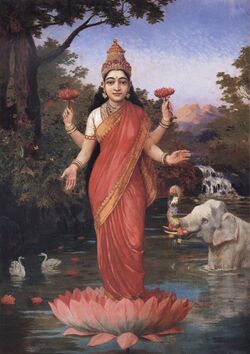Padma (attribute)
Topic: Religion
 From HandWiki - Reading time: 3 min
From HandWiki - Reading time: 3 min
Padma (Nelumbo nucifera, the sacred lotus) is an aquatic plant that plays a central role in Indian religions such as Hinduism, Buddhism, Sikhism, and Jainism. The lotus flower has many different names such as the "Indian Lotus", the "Sacred Lotus", and the "Bean of India".
Symbolism
The lotus (Nelumbo nucifera) is an ancient and polyvalent symbol in Asian culture. Hindus revere it with the gods Vishnu, Brahma and to a lesser degree Kubera, and the goddesses Lakshmi and Saraswati. Often used as an example of divine beauty and purity, Vishnu is often described as the "Lotus-Eyed One". The lotus springs from the navel of Vishnu while he is in Yoga Nidra. The lotus blooms uncovering the creator god Brahma in lotus position.[1] Its unfolding petals suggest the expansion of the soul. The growth of its pure beauty from the mud of its origin holds a benign spiritual promise. Particularly Brahma and Lakshmi, the divinities of potency and wealth, have the lotus symbol associated with them.
The lotus flower is one of the Ashtamangala of Buddhism, representative of creation and cosmic renewal and "primordial purity" (Wylie: ka dag) and shares in the chakra and mandala symbolism of the Dharmacakra.
This has also taken root in Chinese cultures with a famous statement made by the 11th century Confucian scholar Zhou Dunyi: "I love the lotus because while growing from mud, it is unstained."
The padma is held to be a flower with a thousand petals and is therefore associated with the Sahasrara and indeed all the chakra. The padma appears as an endemic dais upon which deities rest and indeed upon which Hindu iconography is founded.
In Buddhist symbolism the lotus is symbolic of purity of the body, speech, and mind as while rooted in the mud, its flowers blossom on long stalks as if floating above the muddy waters of attachment and desire. It is also symbolic of detachment as drops of water easily slide off its petals.
It is also to be noted that many Asian deities are depicted seated on a lotus flower. According to legend, Gautama Buddha was born with the ability to walk and everywhere he stepped, lotus flowers bloomed.
See also
- Nelumbo nucifera
- Lotus (disambiguation)
- Ashtamangala (Eight Auspicious Symbols)
Notes
- ↑ Refer Brahma Samhita.
References
- Dallapiccola, Anna L. (2002). Dictionary of Hindu Lore and Legend. New York: Thames & Hudson. ISBN 0-500-51088-1.
- Lawlor, Robert (1991). Voices Of The First Day: Awakening in the Aboriginal Dreamtime. Rochester, Vermont: Inner Traditions International, Ltd. ISBN:0-89281-355-5
- Shakti M. Gupta (1971). Plant Myths and Traditions in India. Netherlands: Brill Publishers. pp. 65-67. https://books.google.com/books?id=stIUAAAAIAAJ&pg=PA65. Retrieved 25 June 2015.
External links
 KSF
KSF



